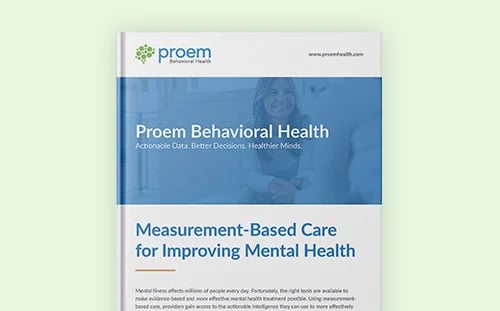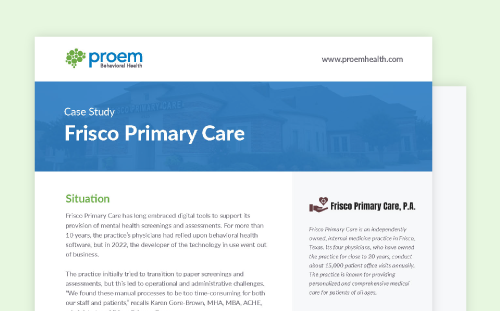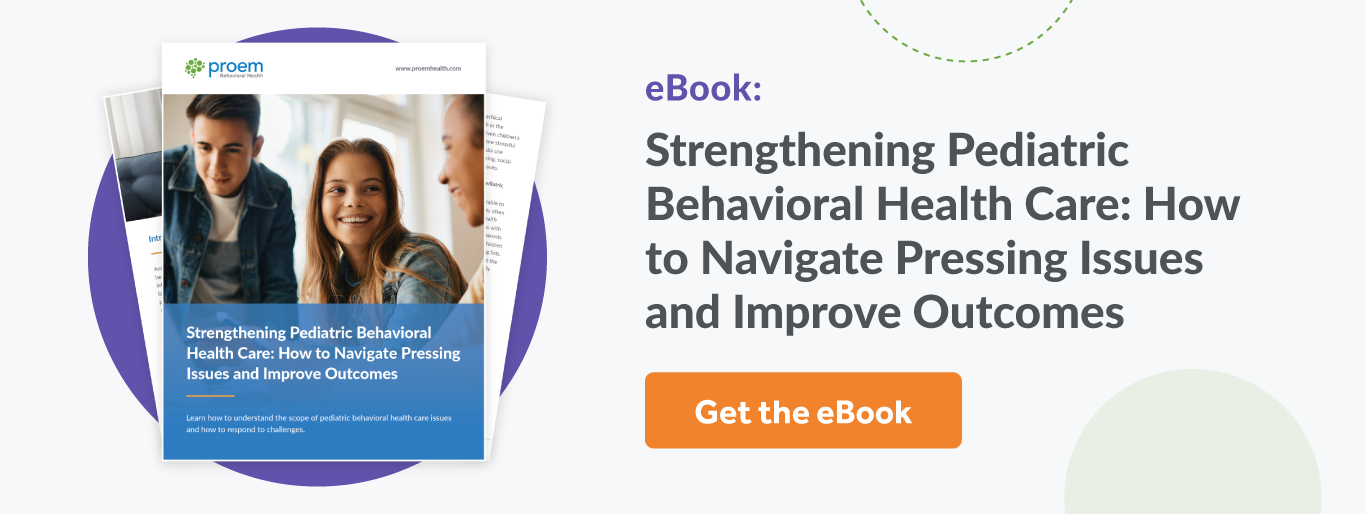There is a critical gap in behavioral healthcare for children. Almost half of all mental illnesses manifest by age 18, and 62.5% show up by age 25. Yet the interval between symptom onset and diagnosis is a staggering 11 years.

Additionally, youth mental health problems are increasing rapidly in prevalence and severity. Between 2016 and 2021, there was a 59% increase in 5- to 19-year-olds presenting at emergency departments with suicidal thoughts. The youth mental health crisis has become so bad that ECRI made the issue its #1 patient safety concern for 2023.
As healthcare providers look for ways to better address these issues, many advocate increasing the use of digital tools to reach and support more young people. In this connected age, digital tools offer hope for our youth.
The Need for New Strategies in Youth Mental Health
Today’s youth are a highly connected age group. Pew Research reports that 97% of teenagers are daily internet users. Close to half of teens are online "almost constantly." Data also shows that 95% of teens have access to smartphones and 90% can access laptops or desktop computers. This level of access suggests the potential of digital screenings and interventions to help revolutionize youth mental health care.
With that in mind, behavioral health specialists have been exploring ways digital access could be leveraged to improve screening and treatment for youth struggling with mental health issues.
As researchers pointed out years ago in the journal NPJ Digital Medicine, clinicians had already begun to realize that behavioral health for children needed to change to reflect the behavior and needs of service recipients, particularly youth. The article goes on to describe how the digital realm provides a unique opportunity for population-relevant care: “Digital medicine and its resulting approach and tools may be crucially relevant for youth mental health in regards to two key aspects: (1) detection of emerging mental disorders; and (2) providing youth-friendly treatment approaches that leverage digital approaches, as well as technologies."
Thanks to technological advancements, today's providers can create an end-to-end system for screening, treating and monitoring youth mental health. This includes more accessible treatment options and routine screenings to keep youth from falling through the cracks.
Now let's look at three of the reasons why the usage of digital tools shows so much promise in improving behavioral health for children.
1. Digital Tools Offer Entry Points for Clinical Care
Digital solutions can bring effective behavioral health for children who lack the ability and/or hesitate to seek in-person services. When designed by clinical experts, mental health screening tools for youth can support provider-led screening while also providing on-demand assistance for help-seeking young people.
Examples of screening tools include the M.I.N.I. Kid, which assesses the 30 most common and clinically relevant disorders or disorder subtypes in pediatric mental health using language tailored to different age groups.
When they're age-appropriate and easy to access, digital mental health screening tools for youth could identify more young people with mental illnesses or risk factors.
Tools are also available for parents — an important factor when treating younger children. For example, researchers from NYU Langone Health's WonderLab have developed a peds questionnaire app series called "When to Wonder." This allows parents to assess children's concerning behavior and helps indicate when to seek professional assistance.
A critical aspect of effectively leveraging digital platforms is ensuring they can help get individuals in need of support to the right professional services. The results from the use of digital screening tools should always end up in the hands of experienced clinicians who can then guide youth and families to the appropriate next steps for diagnosis and treatment.
2. Digital Tools Help Close the Behavioral Health Treatment Gap
Many young people with mental health challenges experience barriers to care. More than three in five children with depression don't receive treatment. For those that do, fewer than 30% receive consistent care.
The reasons for this gap vary. Some barriers are logistical — a lack of transportation or funds, for example. Nationwide, one in 10 young people lacks adequate insurance coverage for mental health care.
Other barriers are social and emotional. A report from the Medical Journal of Australia revealed that even when young people have significant symptoms of depression and anxiety, some avoid seeking help due to stigma or the fear of appearing too dependent. Self-consciousness may also prevent youth from seeking help if they feel their families can't afford care.
If primary care providers and other front-line clinicians have access to effective screening tools and digital interventions, they can connect young people with appropriate and accessible solutions, including virtual and app-based tools if those are what patients prefer. According to a 2020 survey, 41% of Generation Z clients prefer virtual to in-person care — a higher percentage than any other age group. Digital tools can also close the access gap for young people who have transportation challenges or live in rural areas.
Providers must develop an awareness of available digital tools and integrate them into practice. If young people lack access to evidence-based resources, they risk self-treating with unsuitable or poorly designed mental wellness apps which are not targeted to individual needs and are often not evidence-based. As the American Psychiatric Association notes, "Many of the claims by mental health apps have never actually been studied or evaluated in feasibility or clinical trials. The FDA has taken a largely hands-off approach to regulating these apps, and there is currently little-to-no oversight of mental health apps. This can leave the user to distinguish a useful, safe, and effective app from an unhelpful, dangerous and ineffective one."
 Follow Proem Behavioral Health on LinkedIn to help you stay current with the latest behavioral and mental health news.
Follow Proem Behavioral Health on LinkedIn to help you stay current with the latest behavioral and mental health news.
3. Digital Tools Monitor Recovery for Improved Outcomes
To deliver optimal behavioral health for children, interventions and monitoring should be individualized and integrated with in-person care when necessary. This includes regular monitoring of a patient's progress — something digital technologies have made significantly easier.
For instance, a 2018 study used smartphones to capture behavioral data to monitor potential relapse in patients with schizophrenia. Participants' smartphones passively collected data that alerted researchers to behaviors and patterns that signaled a potential return of symptoms.
The tool was able to effectively identify red-flag behavior changes before clinical relapse and do so without active input from the participant. This hands-off approach on the patient's part is an important consideration when treating children and adolescents who may not have the ability or maturity to follow a check-in schedule.
These tools can have a significant impact without requiring significant behavior change — a great benefit for the youth population.
Beyond the Peds Questionnaire: Accessing Mental Health Screening Tools for Youth
While front-line providers hope to be a primary point of contact, young people have doubts. They often do not know whether seeing a general practitioner for a mental health problem will be helpful.
Practitioners can take the burden of help-seeking out of children's and adolescents' hands, making it instead a routine part of clinical care. Proem's behavioral health workflow engine integrates effective mental health screening tools for youth into an organization's existing workflow, making behavioral health for children much more accessible on a broad scale.
Contact Proem today to learn how our solutions give pediatric care providers the tools they need to more accurately and effectively screen and assess children.





.png)









